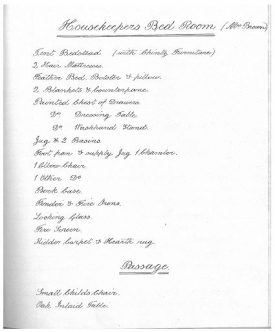The inventory for the housekeeper’s bedroom1 points to her elevated rank in the hierarchy of domestic service. She was the most senior female servant at the castle, matched in importance only by the butler who was the most senior male servant there. Crucially, she did not have to share a bedroom, and her bedroom offered a degree of comfort denied to many other women of her social class.
Her bed was well appointed with a feather bolster and pillow on top of a hair mattress and hung with chintz curtains with a number of bed coverings to keep at bay the inevitable chill of a castle. Should these prove inadequate, there was a fire with all the necessary accoutrements to act as a further defence. The painted chest bore witness to the quantity of clothes a housekeeper was expected to own. An elbow chair, a dressing table, a looking glass and a bookcase, all suggest a level of gentility commensurate with her rank. Certainly, the other rooms of those servants of lower rank were spartan in comparison.
The duties of the housekeeper
In 1853 when the inventory was made, the housekeeper was a Mrs Brown. The use of a title signifies again her importance (indeed, many housekeepers were unmarried), and likewise, the butler would be addressed as Mr. No records survive of her specific duties, but generally housekeepers at establishments such as Warwick Castle would have cared for the contents of the rooms, such as the furniture, the soft furnishings, the plate, the china and paintings, taken responsibility for selected provisioning and supervised junior staff.
Relationships with the family
It was only the most senior servants who would have had sustained contact with their employers. On occasion, such contact resulted in close friendships between master and servant. While the relationship Mrs Brown had with the fourth Earl of Warwick and his Countess remains unknown, two of her predecessors seemed exceptionally attached to their master and mistress. Maria Hume, the housekeeper under the second Earl saved him from bankruptcy by paying off many of his debts. In 1834 she died at the age of 93 years having given 70 years in service to Warwick Castle. Some six years later, the Countess was the chief mourner at the funeral of Mrs Farnhill having returned from the continent to be present for the occasion.
Inventories of Warwick Castle
In 1853, the death of the third Earl and the succession of his son, the fourth Earl was probably the driving force behind the making of the inventory. It is very detailed and provides a fascinating glimpse of the Castle’s interior. Other inventories both before and after attest to its’ changing fortunes.
1 Warwickshire County Record Office reference CR1886/783/16
This article was Document of the Month for the Warwickshire County Record Office in December 2009. Further articles can be found on their website.









Comments
Add a comment about this page